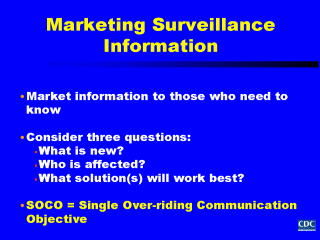| front |1 |2 |3 |4 |5 |6 |7 |8 |9 |10 |11 |12 |13 |14 |15 |16 |17 |18 |19 |20 |21 |22 |23 |24 |25 |26 |27 |28 |review |
 |
Now that we discussed who to provide information to, what information to provide, and the channels through which to provide it, letís talk about how to market surveillance information so that it has the highest likelihood of being heeded and used. One of the most important reasons why we disseminate surveillance information is to help policy makers and intervention program planners use the information to take public health action that will prevent, minimize, and control the spread of disease. In tailoring our presentation to accomplish this, we should present surveillance information in a way so that it can be used to answer three important questions: - What information is new? - Who is affected by the disease or health issue? and, - What solutions, if any, are available, and will work best? Because we often must communicate the significance and implications of surveillance data in a concise manner, once the answers to the above questions are clear, the most important elements of each should be formulated into a simple declarative sentence and used as our single over-riding communication objective, or SOCO. Our SOCO should represent the most important public health message we would like to communicate to policy and program planners. Whenever possible, we should emphasize our SOCO during in-person contacts, oral presentations, and in print and electronic materials. |
| front |1 |2 |3 |4 |5 |6 |7 |8 |9 |10 |11 |12 |13 |14 |15 |16 |17 |18 |19 |20 |21 |22 |23 |24 |25 |26 |27 |28 |review |